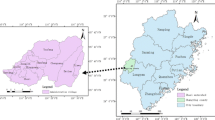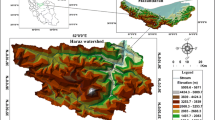Abstract
Soil erosion has become a significant environmental problem that threatens ecosystems globally. The risks posed by soil erosion, the trends in the spatial distribution in soil erosion, and the status, intensity, and conservation priority level in the middle reaches of the Yellow River Basin were identified from 1978 to 2010. This study employed a multi-criteria evaluation method integrated with GIS and multi-source remote sensing data including land use, slope gradient and vegetation fractional coverage (VFC). The erosion status in the study region improved from 1978 to 2010; areas of extremely severe, more severe, and severe soil erosion decreased from 0.05%, 0.94%, and 11.25% in 1978 to 0.04%, 0.81%, and 10.28% in 1998, respectively, and to 0.03%, 0.59%, and 6.87% in 2010, respectively. Compared to the period from 1978 to 1998, the area classed as improvement grade erosion increased by about 47,210.18 km2 from 1998 to 2010, while the area classed as deterioration grade erosion decreased by about 17,738.29 km2. Almost all severe erosion regions fall in the 1st and 2nd conservation priority levels, which areas accounted for 3.86% and 1.11% of the study area in the two periods, respectively. This study identified regions where soil erosion control is required and the results provide a reference for policymakers to implement soil conservation measures in the future.
Similar content being viewed by others
References
Aia L, Fang N F, Zhang B et al., 2013. Broad area mapping of monthly soil erosion risk using fuzzy decision tree approach: Integration of multi-source data within GIS. International Journal of Geographical Information Science, 27: 1251–1267.
Aiello A, Adamo M, Canora F, 2015. Remote sensing and GIS to assess soil erosion with RUSLE3D and USPED at river basin scale in southern Italy. Catena, 131: 174–185.
Alexakis D D, Hadjimitsis D G, Agapiou A, 2013. Integrated use of remote sensing, GIS and precipitation data for the assessment of soil erosion rate in the catchment area of “Yialias” in Cyprus. Atmospheric Research, 131: 108–112. doi: 10.1016/j.atmosres.2013.02.013.
Baffalt C, Nearing M A, Nicks A D, 1996. Impact of GLIGEN parameters on WEPP predicted average soil loss. Transactions of the ASAE, 2: 1001–1020.
Belyaev V, Wallbrink P, Golosov V N et al., 2005. A comparison of methods for evaluating soil redistribution in the severely eroded Stavropol region, southern European Russia. Geomorphology, 65: 173–193.
Beskow S, Mello C R, Norton L D et al., 2009. Soil erosion prediction in the Grande River Basin, Brazil using distributed modeling. Catena, 79: 49–59.
Boardman J, 2006. Soil erosion science: Reflections on the limitations of current approaches. Catena, 68: 73–86.
Boroushaki S, Malczewski J, 2008. Implementing an extension of the analytical hierarchy process using ordered weighted averaging operator with fuzzy quantifiers in ArcGIS. Computers & Geosciences, 34: 399–410.
Carlson T N, Ripley D A, 1998. On the relation between NDVI, fractional vegetation coverage, and leaf area index. Remote Sensing of Environment, 62: 241–252.
Ceballos-Silva A, López-Blanco J, 2003. Delineation of suitable areas for crops using a multi-criteria evaluation approach and land use/cover mapping: A case study in Central Mexico. Agricultural Systems, 77: 117–136.
Chen T, Niu R Q, Li P X et al., 2011. Regional soil erosion risk mapping using RUSLE, GIS, and remote sensing: A case study in Miyun Watershed, North China. Environmental Earth Sciences, 63: 533–541.
David M W, McCabe G J, 2000. Differences in topographic characteristics computed from 100- and 1000-m resolution digital elevation model data. Hydrological Processes, 14: 987–1002.
Deng Z Q, Lima J, Jung H S, 2009. Sediment transport rate-based model for rainfall induced soil erosion. Catena, 76: 54–62.
Drzewieckiw W, Wężyk P, Pierzchalski M et al., 2014. Quantitative and qualitative assessment of soil erosion risk in Małopolska (Poland), supported by an object-based analysis of high-resolution satellite images. Pure and Applied Geophysics, 171: 867–895.
Eastman J R, 2001. IDRISI 32: Guide to GIS and Image Processing. Worcester, USA: Clark Labs, Clark University.
Fan H M, Wang T L, Cai Q G et al., 2008. Study on the zonation differentiation of soil erosion and the model of soil and water conservation in northeast China. Research of Soil and Water Conservation, 15: 69–72. (in Chinese)
Fu B J, Liu Y, Lü Y H et al., 2011. Assessing the soil erosion control service of ecosystems change in the Loess Plateau of China. Ecological Complexity, 8: 284–293.
Fu S H, Cao L X, Liu B Y et al., 2015. Effects of DEM grid size on predicting soil loss from small watersheds in China. Environmental Earth Sciences, 73: 2141–2151.
Gao P, Mu X M, Wang F et al., 2011. Changes in streamflow and sediment discharge and the response to human activities in the middle reaches of the Yellow River. Hydrology and Earth System Sciences, 15: 1–10.
Krois J, Schulte A, 2014. GIS-based multi-criteria evaluation to identify potential sites for soil and water conservation techniques in the Ronquillo watershed, northern Peru. Applied Geography, 51: 131–142.
Lal R, 1998. Soil erosion impact on agronomic productivity and environment quality. Critical Reviews in Plant Sciences, 17: 319–464.
Li R, Shangguan Z, Liu B et al., 2009. Advances of soil erosion research during the past 60 years in China. Journal of Soil and Water Conservation, 5: 1–6. (in Chinese)
Li Z, Cao W, Liu B et al., 2008. Current status and developing trend of soil erosion in China. Journal of Soil and Water Conservation, 1: 57–62. (in Chinese)
Lu D, Li G, Valladares G S et al., 2004. Mapping soil erosion risk in Rondônia, Brazilian Amazonia: Using RUSLE, remote sensing and GIS. Land Degradation & Development, 15: 499–512.
Liu D S, 1964. Loess in the Middle Yellow River Drainage Basin. Beijing, China: Science Press: (in Chinese)
Liu L, Liu X H, 2010. Sensitivity analysis of soil erosion in the northern Loess Plateau. Procedia Environmental Sciences, 2: 134–148.
Luo Y, Yang S T, Zhao C S et al., 2013. The effect of environmental factors on spatial variability in land use change in the high-sediment region of China’s Loess Plateau. Journal of Geographical Sciences, 24: 802–814.
Malczewski J A, 1996. GIS-based approach to multiple criteria group decision-making. International Journal of Geographical Information Science, 10(8): 321–339.
Masoudi M, Patwardhan A M, 2006. Risk assessment of water erosion for the Qareh Aghaj subbasin, southern Iran. Stochastic Environmental Research and Risk Assessment, 21: 15–24.
Meusburger K, Steel A, Panagos P et al., 2012. Spatial and temporal variability of rainfall erosivity factor for Switzerland. Hydrology and Earth System Sciences, 16: 167–177.
Morgan R P C, 2005. Soil Erosion and Conservation, 3rd ed., Blackwell Publishing Company: Malden, MA, USA.
MWRC (Ministry of Water Resources of China), 1997. National Professional Standards for Classification and Gradation of Soil Erosion, SL 190-1996. Beijing, China. (in Chinese)
MWRC (Ministry of Water Resources of China), 2008. SL190–2007: Standards for Classification and Gradation of Soil Erosion. Beijing, China: Water Resources & Hydropower Press of China. (in Chinese)
Ni G H, Liu Z Y, Lei Z D et al., 2008. Continuous simulation of water and soil erosion in a small watershed of the Loess Plateau with a distributed model. Journal of Hydrologic Engineering, 13: 392–399.
Park S, Oh C, Jeon S et al., 2011. Soil erosion risk in Korean watersheds, assessed using the revised universal soil loss equation. Journal of Hydrology, 399: 263–273.
Pimentel D, Harvey C, Resosudarmo P et al., 1995. Environmental and economic costs of soil erosion and conservation benefits. Science, 267: 1117–1123.
Renard K G, Foster G R, Weesies G A et al., 1991. RUSLE, revised universal soil loss equation. Journal of Soil and Water Conservation, 1: 30–33.
Sharda V N, Mandal D, Ojasvi P R, 2013. Identification of soil erosion risk areas for conservation planning in different states of India. Journal of Environmental Biology, 34: 219–226.
Siakeu J, Oguchi T, 2000. Soil erosion analysis and modelling: A review. Transactions of the Japanese Geomorphological Union, 21: 413–429.
Stroosnijder L, 2005. Measurement of erosion: Is it possible? Catena, 2/3: 162–173.
Sun W Y, Shao Q Q, Liu J Y, 2013. Soil erosion and its response to the changes of precipitation and vegetation cover on the Loess Plateau. Journal of Geographical Sciences, 23: 1091–1106.
Sun W Y, Shao Q Q, Liu J Y et al., 2014. Assessing the effects of land use and topography on soil erosion on the Loess Plateau in China. Catena, 121: 151–163.
Thompson J A, Charles B, Butler A, 2001. Digital elevation model resolution: effects on terrain at tribute calculation and quantitative soil–landscape modeling. Geoderma, 100: 67–89.
Tian Y, Zhou Y, Wu B et al., 2009. Risk assessment of water soil erosion in upper basin of Miyun Reservoir, Beijing, China. Environmental Geology, 4: 937–942.
Valente R O A, Vettorazzi C A, 2008. Definition of priority area for forest conservation through the ordered weighted averaging method. Forest Ecological Management, 256: 1408–1417.
Vrieling A, 2006. Satellite remote sensing for water erosion assessment: A review. Catena, 65: 2–18.
Vrieling A, de Jong S M, Sterk G et al., 2008. Timing of erosion and satellite data: A multi-resolution approach to soil erosion risk mapping. International Journal of Applied Earth Observation and Geoinformation, 3: 267–281.
Wang F, Wang C, 2009. Research for the influences of DEM resolution on topographical factors: A case study of Mengyin County. Research of Soil and Water Conservation, 16: 225–230. (in Chinese)
Wang L H, Huang J L, Du Y et al., 2013. Dynamic assessment of soil erosion risk using landsat TM and HJ satellite data in Danjiangkou Reservoir area, China. Remote Sensing, 5: 3826–3848.
Wischmeier W H, Smith D D, 1965. Predicting Rainfall Erosion Losses from Cropland East of the Rocky Mountains, Handbook No.282. US Department of Agriculture (USDA): Washington, DC, USA.
Yang Q Y, Yuan B Y, 1991. Natural Environment of Loess Plateau and Its Evolution. Beijing, China: Science Press. (in Chinese)
Yang S T, Zhu Q, 2000. Effect of man-computer interactive interpretation method in soil erosion survey of large scale by remote sensing. Journal of Soil and Water Conservation, 14: 88–91. (in Chinese)
Zhang S G, Li Y P, Cheng Y D, 2002. Soil erosion and its improvement in Huangjiang Reservoir area in Guangdong province. Journal of Sediment Research, 5: 76–80. (in Chinese)
Zhang X W, Wu B F, Li X S et al., 2012. Soil erosion risk and its spatial pattern in upstream area of Guanting Reservoir. Environmental Earth Sciences, 65: 221–229.
Zhang X W, Wu B F, Ling F et al., 2010. Identification of priority areas for controlling soil erosion. Catena, 83; 76–86.
Zhao X L, Zhang Z X, Liu B et al., 2002. Method of monitoring soil erosion dynamic based on remote sensing and GIS. Bulletin of Soil and Water Conservation, 22: 29–32. (in Chinese)
Zhou W F, Wu B F, 2005. Overview of remote sensing approaches to soil erosion monitoring. Remote Sensing Technology and Application, 20 (5): 537–542. (in Chinese)
Zhou W F, Wu B F, Li Q Z, 2005. Spatial and temporary change analysis of soil erosion intensity in recent 20 years in the upper basin of Guanting reservoir. Research of Soil and Water Conservation, 12: 183–186. (in Chinese)
Zhou X, Yang S T, Liu X Y et al., 2015. Comprehensive analysis of changes to catchment slope properties in the high-sediment region of the Loess Plateau, 1978–2010. Journal of Geographical Sciences, 25: 437–450.
Zhu M Y, 2012. Soil erosion risk assessment with CORINE model: Case study in the Danjiangkou Reservoir region, China. Stochastic Environmental Research and Risk Assessment, 26: 813–822.
Author information
Authors and Affiliations
Corresponding author
Additional information
Foundation: National Natural Science Foundation of China, No.41701517; National Key Project for R&D, No.2016YFC0402403, No.2016YFC0402409
Author: Zhao Haigen (1983–), PhD, specialized in hydrological simulation and remote sensing.
Rights and permissions
About this article
Cite this article
Zhao, H., Tang, Y. & Yang, S. Dynamic identification of soil erosion risk in the middle reaches of the Yellow River Basin in China from 1978 to 2010. J. Geogr. Sci. 28, 175–192 (2018). https://doi.org/10.1007/s11442-018-1466-0
Received:
Accepted:
Published:
Issue Date:
DOI: https://doi.org/10.1007/s11442-018-1466-0




